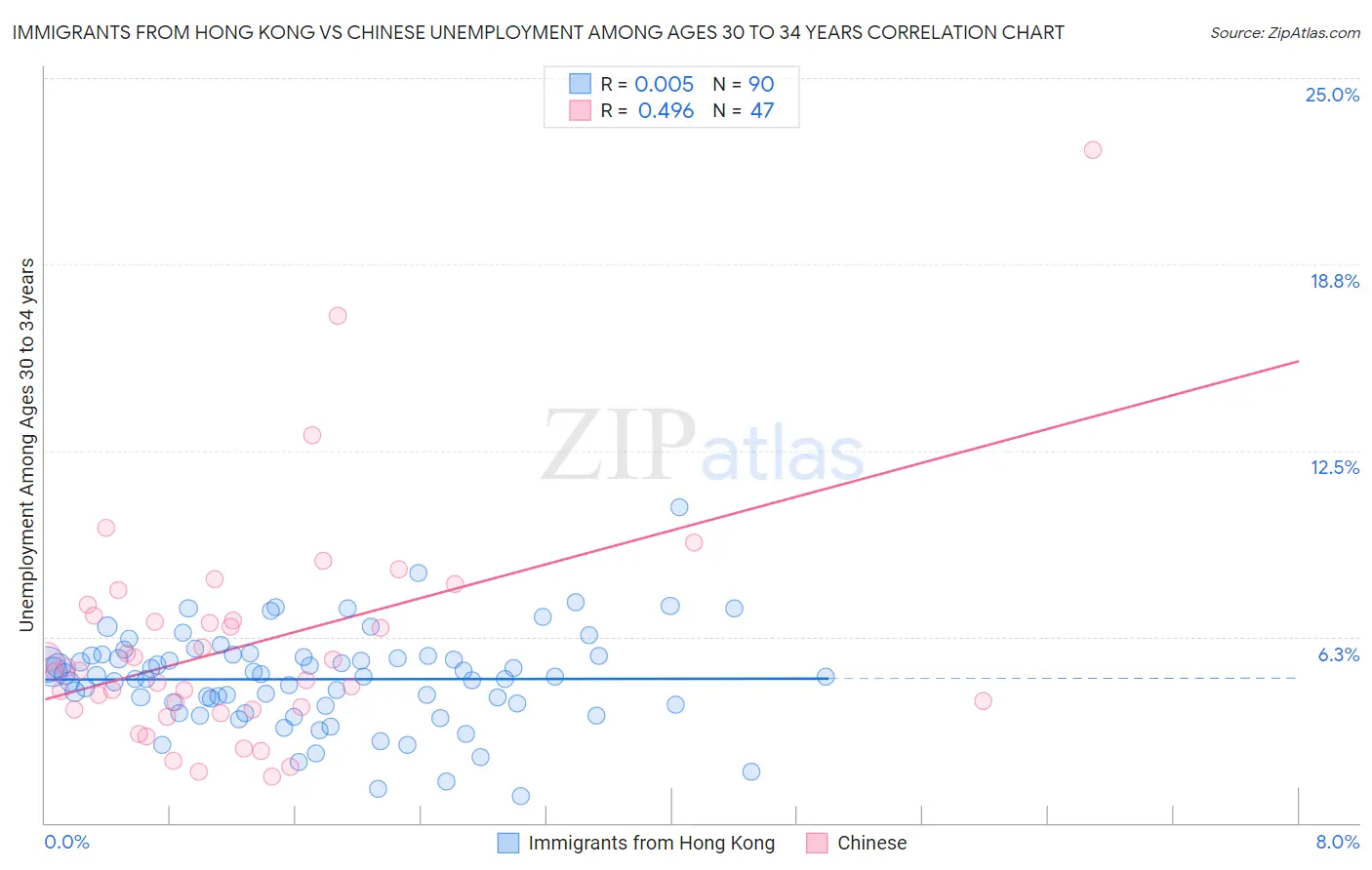Immigrants from Hong Kong vs Chinese Unemployment Among Ages 30 to 34 years
COMPARE
Immigrants from Hong Kong
Chinese
Unemployment Among Ages 30 to 34 years
Unemployment Among Ages 30 to 34 years Comparison
Immigrants from Hong Kong
Chinese
5.0%
UNEMPLOYMENT AMONG AGES 30 TO 34 YEARS
98.8/ 100
METRIC RATING
42nd/ 347
METRIC RANK
5.1%
UNEMPLOYMENT AMONG AGES 30 TO 34 YEARS
97.7/ 100
METRIC RATING
55th/ 347
METRIC RANK
Immigrants from Hong Kong vs Chinese Unemployment Among Ages 30 to 34 years Correlation Chart
The statistical analysis conducted on geographies consisting of 245,493,498 people shows no correlation between the proportion of Immigrants from Hong Kong and unemployment rate among population between the ages 30 and 34 in the United States with a correlation coefficient (R) of 0.005 and weighted average of 5.0%. Similarly, the statistical analysis conducted on geographies consisting of 64,021,968 people shows a moderate positive correlation between the proportion of Chinese and unemployment rate among population between the ages 30 and 34 in the United States with a correlation coefficient (R) of 0.496 and weighted average of 5.1%, a difference of 1.3%.

Unemployment Among Ages 30 to 34 years Correlation Summary
| Measurement | Immigrants from Hong Kong | Chinese |
| Minimum | 0.90% | 1.5% |
| Maximum | 10.6% | 22.6% |
| Range | 9.7% | 21.1% |
| Mean | 4.8% | 6.0% |
| Median | 4.9% | 5.1% |
| Interquartile 25% (IQ1) | 4.0% | 3.8% |
| Interquartile 75% (IQ3) | 5.6% | 7.0% |
| Interquartile Range (IQR) | 1.6% | 3.2% |
| Standard Deviation (Sample) | 1.6% | 3.8% |
| Standard Deviation (Population) | 1.6% | 3.8% |
Demographics Similar to Immigrants from Hong Kong and Chinese by Unemployment Among Ages 30 to 34 years
In terms of unemployment among ages 30 to 34 years, the demographic groups most similar to Immigrants from Hong Kong are Soviet Union (5.0%, a difference of 0.10%), Immigrants from Vietnam (5.0%, a difference of 0.18%), Immigrants from Eastern Africa (5.0%, a difference of 0.18%), Immigrants from Belgium (5.1%, a difference of 0.25%), and Fijian (5.0%, a difference of 0.27%). Similarly, the demographic groups most similar to Chinese are Immigrants from Serbia (5.1%, a difference of 0.19%), Immigrants from Morocco (5.1%, a difference of 0.20%), Immigrants from China (5.1%, a difference of 0.33%), Asian (5.1%, a difference of 0.34%), and Cuban (5.1%, a difference of 0.38%).
| Demographics | Rating | Rank | Unemployment Among Ages 30 to 34 years |
| Sri Lankans | 99.0 /100 | #38 | Exceptional 5.0% |
| Fijians | 99.0 /100 | #39 | Exceptional 5.0% |
| Immigrants | Vietnam | 98.9 /100 | #40 | Exceptional 5.0% |
| Immigrants | Eastern Africa | 98.9 /100 | #41 | Exceptional 5.0% |
| Immigrants | Hong Kong | 98.8 /100 | #42 | Exceptional 5.0% |
| Soviet Union | 98.8 /100 | #43 | Exceptional 5.0% |
| Immigrants | Belgium | 98.7 /100 | #44 | Exceptional 5.1% |
| Yugoslavians | 98.6 /100 | #45 | Exceptional 5.1% |
| Immigrants | Congo | 98.4 /100 | #46 | Exceptional 5.1% |
| Cypriots | 98.4 /100 | #47 | Exceptional 5.1% |
| Assyrians/Chaldeans/Syriacs | 98.4 /100 | #48 | Exceptional 5.1% |
| Immigrants | Malaysia | 98.3 /100 | #49 | Exceptional 5.1% |
| Puget Sound Salish | 98.2 /100 | #50 | Exceptional 5.1% |
| Turks | 98.2 /100 | #51 | Exceptional 5.1% |
| Immigrants | Burma/Myanmar | 98.1 /100 | #52 | Exceptional 5.1% |
| Cubans | 98.1 /100 | #53 | Exceptional 5.1% |
| Immigrants | Morocco | 97.9 /100 | #54 | Exceptional 5.1% |
| Chinese | 97.7 /100 | #55 | Exceptional 5.1% |
| Immigrants | Serbia | 97.4 /100 | #56 | Exceptional 5.1% |
| Immigrants | China | 97.2 /100 | #57 | Exceptional 5.1% |
| Asians | 97.2 /100 | #58 | Exceptional 5.1% |